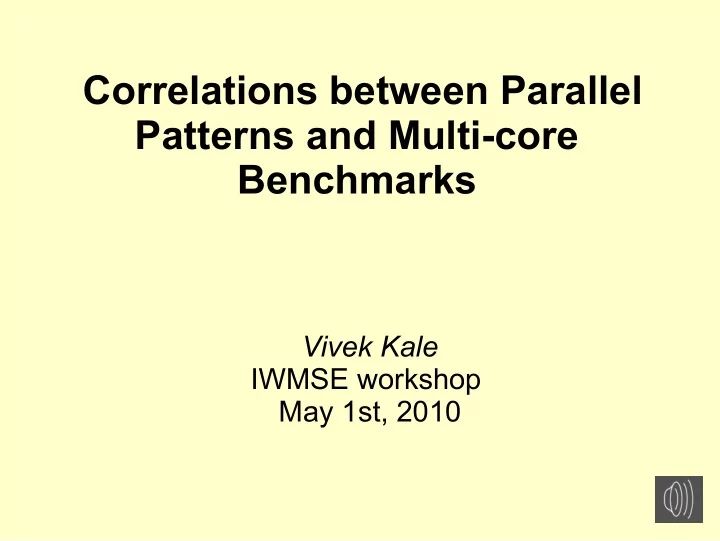

Correlations between Parallel Patterns and Multi-core Benchmarks Vivek Kale IWMSE workshop May 1st, 2010
Challenges for Multi-core Measures for Performance Evaluation of Multicore Defining Parallel Software Development Strategies ● Benchmarks are used in high-performance Parallel Patterns are important for assessing ● scientific computing research and industry for side- the trade-offs between different software by-side -comparison of two or more machines. solutions. ● One scientific computation kernel in a benchmark Parallel patterns must encompass the large ● suite is not enough for side-by-side comparison of variety of solutions parallel programmers use. two machines. One implementation of a benchmark code is not enough for side-by-side comparison of Parallel patterns should not overlap in ● two machines. content, and we should have one standard pattern rather than multiple different versions ● Development of benchmarks that do what other of the same pattern(perhaps written by benchmarks already do may not be productive. different authors). ● With the large variety of parallel architectures, we How do we define a standard methodology ● face a major challenge: how do we provide for a fair that parallel programmers and software performance comparison of such a wide variety of developers can use to take advantage of machines? parallelism of multi-cores?
Parallel Patterns Layers Applications Structural Patterns Computational Patterns Algorithmic Strategy Patterns Implementation Strategy Patterns Parallel Execution Strategy Pattern Coordination Advancing Program Counters
Improving Benchmarks through Parallel Patterns The NAS LU benchmark is a Gauss-Seidel kernel, used for applications involving simulation of heat dissipation and fluid dynamics. Computational Pattern: structured grid LU can be identified directly with a structured grid computation pattern because of the border exchanges involved. Structural Pattern : iterative refinement LU uses the iterative refinement structural pattern because of the outer loop that it iterates over until convergence. Algorithmic Structure Pattern : geometric decomposition LU benchmark involves exchanges of data between neighboring cells in the grid; this requires the use of “halo” or ghost cells. Implementation Pattern: pipeline parallelism Processor 0 starts at the topmost row, while processor 1 starts at one timestep later, using the result of the computation of processor 0 in the first timestep. Processor 2 follows processor 1, and so on. Parallel Execution Strategy Pattern: Depends! NAS LU is now implemented in several different programming libraries.
Benchmark and Pattern Quality Using Patterns to Enrich Benchmarks Portability: Can parallel patterns help to design benchmarks that are more portable? Modularity: Can patterns help to separate a benchmark into modules so as to understand the different parts of a system that a benchmark is testing? Using Benchmarks to Enrich Patterns Scalability: Can scalable solutions in benchmarks explain how scalability is achieved in applications? “Tunability”: How can parallel patterns be enriched by understanding performance tuning techniques used for benchmark codes? Reliable Software: How can benchmarks capturing fault-tolerance of a system tell us how to support fault-tolerance in software?
Conclusions and Future Directions ● General Issue: Controversy over large number of parallel software solutions, and large number parallel architecture. We believe that some consensus on standards is needed for progression for multi-core. ● The use of parallel patterns can strongly benefit benchmarking of multi-core machines, and the use of benchmarks to understand real-world parallel software solutions can be useful in capturing essential parallel patterns. ● The end result will be better organization, standardization, simplicity in both parallel software design and multi-core architectures. Ongoing and Future Directions: 1. More thorough application of Parallel Patterns (OPL) to more of the NAS Parallel benchmarks (we have presented LU only). 2. Consideration of other benchmarks suites: PARSEC, SPEC 3. Addition of more parallel patterns based on documentation of NAS parallel benchmarks.
Thank You! Questions? Feel free to contact me at: vivek@illinois.edu
References 1. Yelick, K. et al. 2009 Technical Report. “A Generalized Autotuning Framework for Stencil Computations”. University of California-Berkeley. 2. Singh, J.P. Kumar, S., Bienia, C., Li, K. 2008 Tech Report. “The PARSEC Benchmark Suite: Characterization and Architectural Implications.” TR 811-08. Princeton University. 3. Johnson, Kuetzer, Mattson et al. Our Pattern Language. 2009. http://parlab.eecs.berkeley.edu/wiki/patterns/patterns 4. Wijngaart, V. “NAS Parallel Benchmarks: Multi-Zone Versions.” NAS Technical Report 03-010. July
Recommend
More recommend